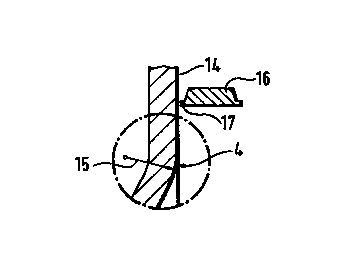Some of the information on this Web page has been provided by external sources. The Government of Canada is not responsible for the accuracy, reliability or currency of the information supplied by external sources. Users wishing to rely upon this information should consult directly with the source of the information. Content provided by external sources is not subject to official languages, privacy and accessibility requirements.
Any discrepancies in the text and image of the Claims and Abstract are due to differing posting times. Text of the Claims and Abstract are posted:
| (12) Patent Application: | (11) CA 2306051 |
|---|---|
| (54) English Title: | SIDE CHANNEL CENTRIFUGAL PUMP |
| (54) French Title: | POMPE A CANAL LATERAL ET FLUX CIRCONFERENTIEL |
| Status: | Deemed Abandoned and Beyond the Period of Reinstatement - Pending Response to Notice of Disregarded Communication |
| (51) International Patent Classification (IPC): |
|
|---|---|
| (72) Inventors : |
|
| (73) Owners : |
|
| (71) Applicants : |
|
| (74) Agent: | MARKS & CLERK |
| (74) Associate agent: | |
| (45) Issued: | |
| (86) PCT Filing Date: | 1997-11-10 |
| (87) Open to Public Inspection: | 1999-05-20 |
| Examination requested: | 2002-01-09 |
| Availability of licence: | N/A |
| Dedicated to the Public: | N/A |
| (25) Language of filing: | English |
| Patent Cooperation Treaty (PCT): | Yes |
|---|---|
| (86) PCT Filing Number: | PCT/EP1997/006236 |
| (87) International Publication Number: | WO 1999024719 |
| (85) National Entry: | 2000-04-11 |
| (30) Application Priority Data: | None |
|---|
The invention relates to a side channel centrifugal pump with a housing
forming a side channel (1). The housing surface adjacent to the side channel
forms a front face (13) adjoining the impeller. The transition edge (2, 3, 7)
between the side channel (1) and the front face (13) is rounded in the areas
where it deviates from the circumferential direction. In the front plane, the
blades (16) of the impeller have a predetermined web width in the
circumferential direction. According to the invention, the radius (15) of the
transition edge (7) is greater than 0.25 (sec/m) times the product of web
width x blade speed where the impeller blades (16) exit from the front face
(13, 14) and overlap into the area of the side channel (1). This reduces
cavitation tilting and noise.
L'invention concerne une pompe à canal latéral et flux circonférentiel dotée d'un carter formant un canal latéral (1). La surface du carter, adjacente au canal latéral, constitue une face frontale (13) avoisinant la roue-hélice. Le bord de transition (2, 3, 7) entre le canal latéral (1) et la face frontale (13) est arrondi dans les zones où il s'écarte de la direction circonférentielle. Les ailettes (16) de la roue-hélice ont dans le plan frontal une largeur d'âme prédéterminée dans le sens circonférentiel. Selon l'invention, le rayon (15) du bord de transition (7) est supérieur à 0,25 (sec/m) fois le produit Largeur d'âme x Vitesse des ailettes, là où les ailettes (16) de la roue-hélice quittent la zone de la face frontale (13, 14) pour mordre sur la zone du canal latéral (1). Cela permet de réduire l'inclinaison de cavitation et le bruit.
Note: Claims are shown in the official language in which they were submitted.
Note: Descriptions are shown in the official language in which they were submitted.

2024-08-01:As part of the Next Generation Patents (NGP) transition, the Canadian Patents Database (CPD) now contains a more detailed Event History, which replicates the Event Log of our new back-office solution.
Please note that "Inactive:" events refers to events no longer in use in our new back-office solution.
For a clearer understanding of the status of the application/patent presented on this page, the site Disclaimer , as well as the definitions for Patent , Event History , Maintenance Fee and Payment History should be consulted.
| Description | Date |
|---|---|
| Application Not Reinstated by Deadline | 2003-11-10 |
| Time Limit for Reversal Expired | 2003-11-10 |
| Deemed Abandoned - Failure to Respond to Maintenance Fee Notice | 2002-11-12 |
| Letter Sent | 2002-01-28 |
| Amendment Received - Voluntary Amendment | 2002-01-09 |
| Request for Examination Received | 2002-01-09 |
| All Requirements for Examination Determined Compliant | 2002-01-09 |
| Request for Examination Requirements Determined Compliant | 2002-01-09 |
| Inactive: Cover page published | 2000-06-21 |
| Inactive: First IPC assigned | 2000-06-11 |
| Inactive: Notice - National entry - No RFE | 2000-06-02 |
| Letter Sent | 2000-06-02 |
| Application Received - PCT | 2000-05-29 |
| Application Published (Open to Public Inspection) | 1999-05-20 |
| Abandonment Date | Reason | Reinstatement Date |
|---|---|---|
| 2002-11-12 |
The last payment was received on 2001-10-11
Note : If the full payment has not been received on or before the date indicated, a further fee may be required which may be one of the following
Please refer to the CIPO Patent Fees web page to see all current fee amounts.
| Fee Type | Anniversary Year | Due Date | Paid Date |
|---|---|---|---|
| MF (application, 2nd anniv.) - standard | 02 | 1999-11-10 | 2000-04-11 |
| MF (application, 3rd anniv.) - standard | 03 | 2000-11-10 | 2000-04-11 |
| Registration of a document | 2000-04-11 | ||
| Basic national fee - standard | 2000-04-11 | ||
| MF (application, 4th anniv.) - standard | 04 | 2001-11-12 | 2001-10-11 |
| Request for examination - standard | 2002-01-09 |
Note: Records showing the ownership history in alphabetical order.
| Current Owners on Record |
|---|
| STERLING FLUID SYSTEMS (GERMANY) GMBH |
| Past Owners on Record |
|---|
| PETER FANDREY |